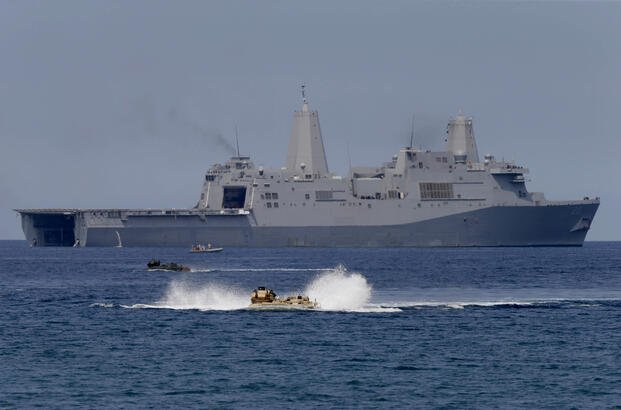China Accuses Regional Patrol in Philippines of 'Escalating Tensions'

China issued a sharp warning after U.S., Philippine and Japanese ships pushed through contested waters in the West Philippine Sea, challenging Beijing’s sweeping maritime claims and spotlighting one of the world’s most sensitive security flashpoints.
The three nations carried out the coordinated patrol on Nov. 14 inside the Philippines’ exclusive economic zone—a stretch of water Beijing claims as part of its South China Sea map despite a ruling rejecting those assertions. The operation featured U.S. carrier movements and joint maneuvers meant to reinforce regional security. China accused the three allies of provoking instability but did not cite any specific incidents at sea.
A senior administration official told Military.com the White House views China’s behavior as destabilizing, saying China’s “sweeping territorial and maritime claims in the South China Sea and its increasingly coercive actions to advance them at the expense of its neighbors continue to undermine regional stability and fly in the face of its prior commitments to resolve disputes peacefully.”
The official reaffirmed that Article IV of the 1951 U.S.-Philippines Mutual Defense Treaty applies to armed attacks on Philippine forces, vessels, or aircraft — including its Coast Guard — anywhere in the South China Sea, adding: “We are closely monitoring the situation in the South China Sea and remain committed to our alliance with the Philippines. The United States is and will always be a Pacific naval power.”
The move follows a series of recent escalations across the region. Earlier this year, U.S. forces briefly deployed two warships[1] to a disputed South China Sea shoal after a Chinese vessel collided with a Philippine Coast Guard ship—an incident that underscored the rising risk of confrontation among regional militaries.
'Escalating Tensions'
China’s Southern Theater Command said its forces monitored the patrol closely and accused the three allies of raising tensions.
“The Philippines has been frequently colluding with external forces to carry out so called joint patrols, which seriously undermine regional peace and stability,” Senior Col. Tian Junli of the PLA Southern Theater Command said in a statement published by the Xinhua New Agency, the official state news media outlet of the People's Republic of China. “We urge the Philippine side to immediately stop provoking incidents and escalating tensions.”
Beijing continues to insist it has “historic rights” to the waters despite a 2016 Hague tribunal ruling that invalidate its claims.
Chinese officials did not respond to Military.com’s requests for comment.
State media followed with additional statements portraying the patrol as harmful to regional stability. China did not specify whether its naval or coast guard ships shadowed the operation.
Details Remain Limited
A U.S. Defense Department official confirmed to Military.com that the U.S., Japan and the Philippines conducted the Nov. 14 activity inside the Philippines’ exclusive economic zone, saying that the operation “demonstrated a collective commitment to strengthen regional and international cooperation in support of a free and open Indo Pacific” and that the patrol “proceeded safely and without disruption.”
Neither U.S. Pacific Fleet officials nor officials in Japan and the Philippines responded to inquiries.
U.S. officials previously said multilateral maritime activities with Japan and the Philippines support a free and open Indo Pacific, but they did not address this specific patrol.
The patrol also comes as the U.S. expands regional deterrence efforts. Earlier this month, Washington approved South Korea’s plan[2] to build its first nuclear-powered attack submarine—a move analysts say signals a broader shift in U.S. posture across the Indo-Pacific.
Philippines Deepens Cooperation with Allies
The Philippines has strengthened its partnerships amid repeated encounters with Chinese Coast Guard ships across the West Philippine Sea.
Manila argues that joint patrols and closer coordination with the U.S. and Japan reinforce its rights inside its exclusive economic zone and deter further Chinese interference.
The Nov. 14 operation appeared to underscore that strategy by placing allied ships, including a U.S. carrier group, inside waters China wants to control.
Joint Patrols Expected to Continue
More joint maritime activities are expected.
The Philippines and U.S. have announced more than 500 planned military engagements for 2026, including expanded naval operations with partners such as Japan.
That plan, along with previous trilateral commitments outlined by Washington and Manila, signals continued cooperation at sea and has drawn repeated objections from Beijing.
© Copyright 2025 Military.com. All rights reserved. This article may not be republished, rebroadcast, rewritten or otherwise distributed without written permission. To reprint or license this article or any content from Military.com, please submit your request here[3].